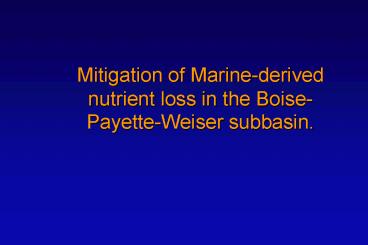Mitigation of Marinederived nutrient loss in the BoisePayetteWeiser subbasin' - PowerPoint PPT Presentation
1 / 29
Title:
Mitigation of Marinederived nutrient loss in the BoisePayetteWeiser subbasin'
Description:
Understand the effects of nutrient treatment applications on riparian conifers. Why conifer foliage? ... Collect current year, sun-grown conifer foliage along ... – PowerPoint PPT presentation
Number of Views:27
Avg rating:3.0/5.0
Title: Mitigation of Marinederived nutrient loss in the BoisePayetteWeiser subbasin'
1
Mitigation of Marine-derived nutrient loss in the
Boise-Payette-Weiser subbasin.
2
- Dr. Kaathleen Kavanagh, University of Idaho
- Dr. Charles Robbins, Washington State University
- Dr. Mark Wipfli, Pacific Northwest Research
Station - Gregg Servheen, Idaho Department of Fish and Game
3
(No Transcript)
4
Why are we interested?
Wild (non-hatchery) anadromous fishes have
declined sharply in Idaho.
5
Background
- Assuming each carcass (FW) is 3.03 nitrogen
(Larkin and Slaney 1997), over 3 million
kilograms of nitrogen (N) were carried into the
Columbia basin each year. (with a lot of
assumptions-3kg/ha yr deposited in riparian
areas.)
6
Background
- Historically, anadromous fish represented a gross
input of 103 million kilograms of organic
material in the form of fish carcasses into the
Columbia Basin each year. (Gresh et al. 2000).
7
Salmon Drive a Positive Feedback
Ocean Ecosystem
Freshwater Ecosystem
Terrestrial Ecosystem
8
Salmon link ocean and land-based ecosystems
9
Nutrients carbon leach from salmon carcasses
10
Estimated contributions of salmon carcasses to
the N-cycle.
Source
N kg ha-1 year-1
Salmon carcasses (in riparian areas)
3
Wet deposition in central Idaho
1
Dry deposition in central Idaho
lt0.5
N-fixation(closed canopy forest, few N-fixers)
0.1
11
(No Transcript)
12
Can ecosystem productivity and nutrition be
restored ?
13
Hypothesis
- Salmon and steelhead contributed measurable and
benefitting quantities of marine-derived
nutrients to aquatic and terrestrial ecosystems
in the subbasin.
14
Nutrient Treatments
- Salmon carcasses
- surplus to hatchery needs
- Salmon analogs
- manufactured and fish-derived
15
Treatment Areas
- Historic salmon use
- Bull trout distribution
- Grazing
- Replication
16
(No Transcript)
17
Aquatic Monitoring Objectives Understand the
effects of nutrient applications on 3 different
trophic levels with the aquatic system.
18
Upper Trophic Level Fishes biomass, density,
marine isotope levels
19
Mid Trophic Level - Invertebrates density, mass,
marine isotope levels
20
Lower Trophic Level Biofilm mass, chlorophyll
a, marine isotope levels
21
Vegetative Monitoring ObjectiveUnderstand the
effects of nutrient treatment applications on
riparian conifers.
22
Why conifer foliage?
- N is major limiting nutrient.
- When N is limiting, N translocation and retention
increases. - Provides an historic context on the contribution
of salmon carcasses after salmon have been
eliminated.
23
(No Transcript)
24
Study design
Collect current year, sun-grown conifer foliage
along transects perpendicular to treated and
control stream reaches.
Mainstem
Tributary
Bankside
Adjacent Upslope
Upslope
Transects
25
Stream-Riparian Linkages
26
Nutrient inputs from aquatic to terrestrial.
- Nutrient from anadromous fish (salmon
steelhead) carcasses through - Ground water
- Deposition
- Predators
27
Terrestrial Monitoring ObjectiveQuantify
contribution of nitrogen from treatments within
terrestrial food chain
28
(No Transcript)
29
Cooperators Washington State University Un
iversity of Idaho Pacific Northwest Research
Station USFS Boise National Forest
Rocky Mountain Research
Station Idaho Department of Fish and Game































